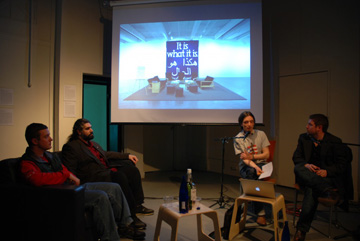On March 28th, Philadelphia hosted a day-long marathon dialogue on the intersections of art and the possibility of social/political change. The day’s events included a symposium on Curating and Activism at the Moore College of Art & Design and a local stop-over of Jeremy Deller’s It Is What It Is: Conversations About Iraq. Continuing from his last post, Daniel Fuller, Senior Program Specialist at the Philadelphia Exhibitions Initiative, recaps Deller’s project.

Photo by Tasha Doremus
After being obsessed for years with books and TV documentaries on the conflict in Iraq, Jeremy Deller conceived It Is What It Is: Conversations About Iraq, as a mobile museum that would bring the emphera of war to American towns. Deciding it would be disingenuous to preemptively respond to and articulate a partial history of an unfinished war, he decided to bring together those with first-person experience in Iraq to talk about it while others, including himself, listened. Deller admits, “I’m a nosy person.”
So, with the help of Creative Time curator Nato Thompson, Deller assembled a road trip crew. Jonathan Harvey, an Army Platoon Sergeant (and Philadelphia native); Esam Pasha, an Iraqi-born translator, artist, and journalist; and Lonnie, the road manager, joined Deller and Thopson and headed out on a three-week, thirteen city, cross-country tour. After nearly six weeks at the New Museum, the crew spent two days in the South—in Washington, DC, right on the National Mall and on the campus of Virginia Commonwealth University in Richmond. We were lucky enough to persuade them to make a loop up to Philadelphia before heading west to Cincinnati.

Photo by Tasha Doremus
As soon as we broke for lunch, the vast majority of the Curating & Activism panelists and observers hustled out to the Parkway in hopes of hailing a cab to take us over to the National Constitution Center on Independence Mall. A visitor to this section of Old City on a Saturday afternoon is generally greeted by reenactors adorned in colonial costumes, Ride The Ducks tour quacks, and horse-drawn carts on cobblestone streets. On this particular day, as we pulled up to the Mall, we saw a Winnebago towing a demolished, burned-out car parked in front of the “We The People” wall of the Constitution Center. In 2007, a car bomb was detonated on Al-Mutanabbi Street in an intellectual and literary Baghdad neighborhood. The vehicle housing the bomb was obliterated, but the shell of a car we saw in Old City had been parked further down the same Baghdad street. Serving as something of a monument for the 38 people who lost their lives to that bomb, it was a heartbreaking visual spectacle.
During our short lunchtime assembly, it was great to see the project being received so sincerely by an audience of tourists patriotic enough to spend a day in the cradle of the American Revolution. Pasha and Harvey seemed completely at ease, putting faces and voices behind a country and war to which we Americans are all now inextricably tied. They engaged the viewers in a dialogue that connected to the sting of alienation some of us feel when we have no place to express our grievances. The pair was respectful to all exchanges, all ideologies, and offered in return the best straightforward, non-partisan responses they could provide given the messy, unresolved situation. The day was not about headlines sanitized through the media and it didn’t try to draw definitive conclusions. It was about direct connections with those that have survived the ongoing Iraqi violence.
As a nightcap, our entire symposium again trekked over to a packed Slought Foundation where we were treated to further explanation of the project and a question-and-answer session with Deller, Nato, Pasha, and Harvey. Throughout the conversation, the four maintained their mission was not a formal declaration of their stance on the war. Some audience members called this provocation and accused them of being morally bankrupt. Of course, as informed rational beings they each have a position on the conflict, but the RV—with its dreadful object towed behind—is not intended to be about them. They are presenters, impartial facilitators of dialogue. For me, it seemed in the end that whichever side of the issue you fell on—anti-war or pro-war (like the Catholic nun who stopped by the RV in the afternoon)—viewing the destroyed car would reaffirm your position. Perhaps the greatest benefit to this project has been for soldiers who were able to share unscripted, cathartic tales with others who have been through similar ordeals. As a civilian, watching from afar, I cannot begin to fathom coming to terms with the aftermath of their job. A video on the project’s website (where you can follow the project’s cross-country trail) shows a college-age veteran calmly trading horror stories with Pasha and Harvey as his girlfriend quietly, uncomfortably, stands by. It is clear as you watch her face that he is telling stories she had never heard—that what he is sharing are things he thought he shouldn’t burden her with.
As Harvey pointed out, military humor is macabre, its darkness a coping mechanism and a way of distancing soldiers from the situation. They have a special way of looking at their job—to “keep rolling,” to “stay the course.” Even in the dimness of violence, “it is what it is.”



